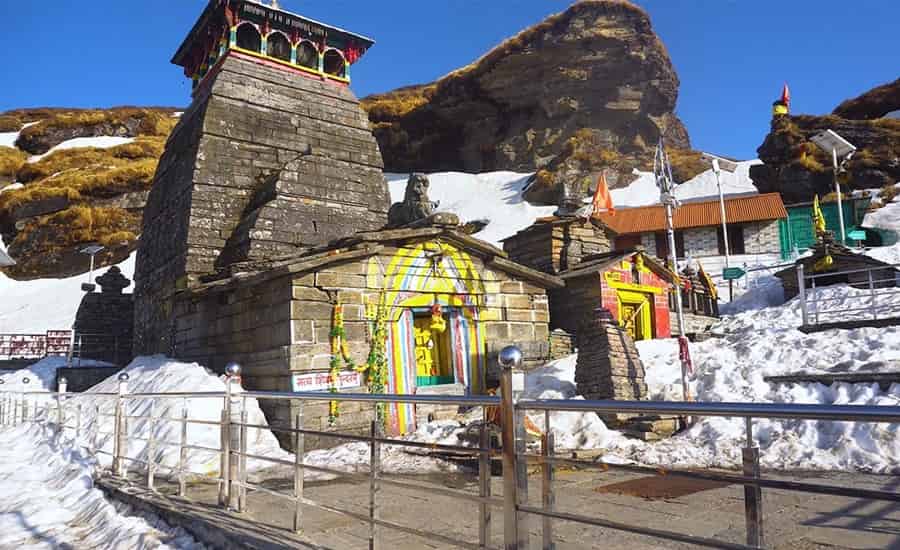Tungnath Temple, nestled in the Garhwal Himalayas of Uttarakhand, India, holds a significant place in Hindu mythology and history. Standing at an elevation of 3,680 meters (12,073 feet), it is considered the highest Shiva temple in the world. The temple is part of the Panch Kedar, a group of five sacred shrines dedicated to Lord Shiva in the Garhwal region. To delve into the history of Tungnath, one must explore its ancient roots, cultural significance, and the tales that surround its existence.

Ancient Origins
The origins of Tungnath Temple date back thousands of years, and its history is intertwined with Hindu mythology. According to legend, after the battle of Kurukshetra in the Mahabharata, the Pandavas sought penance for their sins of killing their own kin. Lord Shiva, displeased with them, transformed into a bull and went into hiding in the Himalayas. The Pandavas, determined to find Shiva, followed him. It is believed that Tungnath is the place where the arm of Lord Shiva appeared, marking the highest of the Panch Kedar.
Construction and Architecture
The construction of Tungnath Temple is said to have been initiated by Arjuna, one of the Pandava brothers. Over the centuries, various rulers and devotees contributed to the temple’s development and maintenance. The architecture of Tungnath reflects the ancient North Indian style, with a simple yet elegant structure. The temple is made of stone and is adorned with intricate carvings. The sanctum sanctorum houses the sacred Shiva lingam, and the temple complex includes other smaller shrines dedicated to different deities.
Cultural Significance
Tungnath holds immense cultural and religious significance for Hindus, drawing pilgrims and tourists alike. The temple is part of the Char Dham Yatra, a revered pilgrimage circuit in the Indian Himalayas. Devotees believe that visiting Tungnath and the Panch Kedar shrines cleanses them of their sins and bestows divine blessings. The trek to Tungnath is not just a physical journey but also a spiritual one, symbolizing devotion and determination.
Historical Events and Renovations
Throughout its long history, Tungnath Temple has witnessed various historical events and undergone renovations. The region faced invasions and conflicts, leading to periods of neglect and destruction. However, the temple was always rebuilt and restored by devoted rulers and followers of Lord Shiva. Renovations in the modern era have focused on preserving the temple’s ancient architecture while ensuring its structural integrity.
Cultural Practices and Festivals:
Tungnath is not only a place of worship but also a hub for cultural practices and festivals. The temple attracts a multitude of devotees during the annual Shiva Ratri festival, celebrated with great fervor. Pilgrims embark on the arduous trek to Tungnath, seeking the divine presence of Lord Shiva during this auspicious time. The rituals performed at the temple reflect centuries-old traditions, offering a glimpse into the rich cultural heritage of the region.
The Trek to Tungnath:
The journey to Tungnath involves a trek through picturesque landscapes, dense forests, and challenging terrains. The trek starts from Chopta, known as the “Mini Switzerland of Uttarakhand,” and passes through scenic meadows and rhododendron forests. The breathtaking views of the snow-capped Himalayas accompany trekkers on their ascent to Tungnath. The trek itself is a test of physical endurance and spiritual commitment.
Preservation Efforts:
In recent times, there has been a growing awareness of the need to preserve Tungnath Temple and its surroundings. Environmental concerns, such as deforestation and waste management, have prompted conservation efforts. Organizations and government initiatives aim to maintain the ecological balance of the region while ensuring that pilgrims can continue to visit this sacred site without causing harm to the environment.
Conclusion
Tungnath Temple, with its ancient origins, cultural significance, and breathtaking location, stands as a testament to the enduring spirit of Hindu devotion and architectural brilliance. The history of Tungnath is not merely a chronological account of events but a narrative woven with myths, legends, and the unwavering faith of generations. As pilgrims continue to make the arduous trek to this sacred abode, Tungnath remains a symbol of spiritual awakening and a connection to the divine in the heart of the Himalayas.
Also Read:

 Call
Call WhatsApp
WhatsApp Enquiry
Enquiry